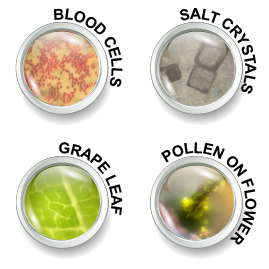PNNL Smartphone Microscope
Available for licensing in some fields
3D Printed Microscope for Mobile Devices that Costs Pennies
Summary
Combine your iPhone or tablet with a 3D-printed clip and glass sphere to create an inexpensive, yet powerful, microscope. Download the files at the bottom of this page to print your own microscope.The microscope slips over the camera lens of the cell phone and is no thicker than a phone case. It’s designed to fit most cell phone brands, including iPhone 4 and 5, Galaxy S3 and S4 phones and iPads. The material cost, not including the printer, is under $1.
Using inexpensive glass beads traditionally used for reflective pavement markings at airports, the PNNL team has demonstrated 1000x magnification, which is necessary to see tiny anthrax spores and plague cells. They have also made a 350x version, which is adequate to identify parasites in blood samples or protozoa in drinking water. A 100x version enables children to investigate common items like salt grains and flower petals in much greater detail.
Using glass spheres as a microscope lens is not a new idea, optically, but the small size of the housing combined with very high magnification and extremely low cost is what makes this device practical.
Low cost was a driver in the research and development project targeting a specific Department of Homeland Security need for rapid bio detection technologies. The microscope needed to be so cheap it could literally be thrown away – in case it gets contaminated.
"We feel there are many uses out there including human and veterinary medicine in developing countries," said Janine Hutchison a microbiologist at PNNL. "We are also really excited about engaging kids in science. School districts have a hard time providing enough microscopes for students. Our science education staff is getting it into the hands of local school children this fall through the auspices of the Mid-Columbia STEM Education Collaboratory."
Troubleshooting Tips
Start with the 100x version if possible. Learning and getting familiar with the system using the lowest magnification possible will increase the usefulness with the higher magnification versions. The higher magnification versions are more sensitive to alignment and take more time and practice to produce good images.
The lens must be pushed into the plastic housing until the front of the lens is flush with the housing. If the camera is having trouble focusing on an object, double check the lens placement to make sure the lens is fully seated in the plastic.
If the image has blurry or dark spots that never change no matter what you are imaging, it could be from a dirty lens or defects in the lens. Try to clean the lens using water or rubbing alcohol and a soft cloth or tissue. If this doesn’t help, and if the image is degraded too much due to these defects, pop out the lens and replace it with a new one.
Lens Specifications
The bead sizes below correspond to the 3D printer files for each magnification. Each printer will have a unique level of shrinkage that will slightly impact the hole diameter where the bead sits. Printing a few prototypes on your printer, or increasing the hole size carefully with a small drill bit or needle after the fact can help adjust for the shrinkage if the hole was printed too small.
The 100x version requires a bead with a 3mm diameter
All 350x versions require a bead with approximately 1mm diameter
The 1000x version requires a bead with a 0.3mm diameter.
Please note the inexpensive beads come in a variety of qualities. Bubbles, defects, and slightly misshapen spheres are all expected within the bead selection. Do your best to choose a bead that appears as round as possible and also as clear as possible.
3D Printer Files (must have 3D printer software to open files)
- 100X Multi-Platform
- 350X Multi-Platform
- 350X Multi-Platform w/ Slideholder
- 350x iPhone 5s
- 1000x iPhone 5s
Beads used by PNNL
http://www.biospec.com/product/297/glass_beads/
Cat. No. 11079110
http://www.mo-sci.com/
GL-0179B/3000
Other bead sources
http://www.sigmaaldrich.com/catalog/product/aldrich/z265926?lang=en®ion=US
http://www.avogadro-lab-supply.com/item/3_mm_Flint_Glass_Beads_Column_Packing_1_lb/803
If you would like more information about this work then contact Janine.Hutchison@pnnl.gov.
For trouble shooting your 3D printer, please visit http://www.thingiverse.com.
What if I don’t have a 3D printer?
There are vendors who will 3D print existing designs for a fee. While we do not have direct experience with or endorse the following suppliers, you may be able to upload the cell phone microscope clip designs and have them printed for you. You would still need to acquire the glass bead to put into the clip housing.
http://www.imakr.com/print_on_demand
http://www.sculpteo.com/en/cloud/
http://www.shapeways.com/create?li=nav

No comments:
Post a Comment
Note: Only a member of this blog may post a comment.